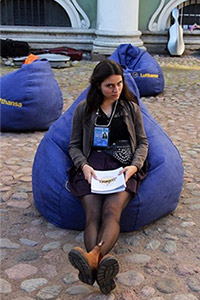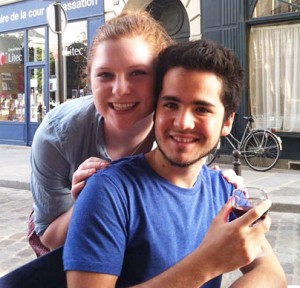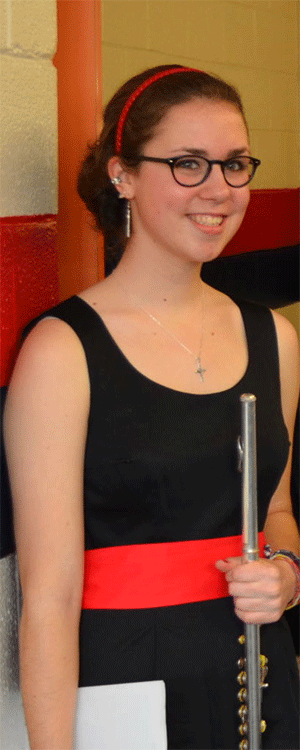Student Spotlight: Johnny Mathews at Urban Bush Women
This post is part of a series of posts by students who are part of our 21st Century Student Internship program. As part of the paid internship program, students spend several weeks with a company that’s on the UMS season.
U-M student Johnny Mathews was paired with Urban Bush Women in Summer 2017. Urban Bush Women perform in Ann Arbor on January 12, 2018.
 Photos: Group photo of all Urban Bush Women’s Student Leadership Institute (SLI) participants at the end of the Culminating Performance
Photos: Group photo of all Urban Bush Women’s Student Leadership Institute (SLI) participants at the end of the Culminating Performance
This summer, thanks to UMS’s 21st Century Artist Internship program, I was able to spend two months in New York City and had experiences that surely changed my life in known and unknown ways. I was placed within, 33-year-old dance company, Urban Bush Women (UBW), a Brooklyn-based dance company dedicated to sharing stories of the African diaspora and committed to enacting social change through dance and workshops. Most of my time with the company was focused on preparing for UBW’s Summer Leadership Institute (SLI). I assisted in administrative work to help the administrative staff as they readied all that goes into having a long workshop for over one hundred participants and staff.
This ten-day intensive program was entitled: You, Me, We – Understanding Internalized Racial Oppression and How It Manifests in Our Artistic Community. SLI consisted of dance classes that was accessible for every body–type, size, ability– to do and be involved in. These dance classes were used as ways to share different African-American dance traditions, such as the ring-shout, the Second Line, and J-Setting. Dance was just a small portion of the day, however. The first seven days of the program were focused on discussions about racism and how it manifests in our community, as well as how and what we can do as artists to help combat racism.
This first meant that we had to truly understand the systems and operations that have been in place in our country that have systematically oppressed marginalized communities. These workshops were led by an organization that works to undermine racism in communities around the country: The People’s Institute for Survival and Beyond (PISAB). I learned so much from these workshops, and my frame of reference was completely shifted with respect to how I think and talk about racism in America. I still find myself processing a lot of the information that was presented and discussed to this day.


Photos: On left, Vincent Thomas passionately leading class at SLI. On right, volunteers who helped with Black Velvet Fundraising Performance Art Event at the 14th St Y.
For the last few days of the program, the focus shifted to actually creating a culminating performance that would be presented to an audience. The way this was created was really special and something that I had never been a part of before. Instead of having one leader or creator heading the creative process, the show was created very democratically. It started with the entire community coming together and sharing what they bring to the table; whether it be music, singing, theatre, poetry, sound and light design, dance, etc. Then the performance was created by the people and allowed for everyone to showcase their best talents and abilities. Seeing the entire community come together to build upon each other’s talents was inspiring and made me think about how this can be replicated in all aspects of art making.
Though this culminating performance seemed to be the culmination of my weeks of work, there was one more part of my internship: I was able to accompany the dance company on a four-day tour to Akron, Ohio. This was a truly immersive, educational experience. I was able to follow the co-artistic directors, the company members, the company manager, and the technical director as they traversed all that comes with a quick, one-stop tour. This tour was presented by the Heinz Poll Summer Dance Festival and was composed of two performances, a master class, and a post-show talk back. Something really interesting to see was how adaptable everyone had to be on this tour.
UBW was performing excerpts from Walking with Trane and portions of their 30th Anniversary Collage, two works that the company was not currently working on. Therefore, the dancers had only one or two rehearsals together in Akron to put these works back together. Not only were they putting it together, but they were rearranging the works while we were there, with everyone adapting to the changes perfectly. I was allowed an insider’s look into how a world-class dance company interacts with a presenter, a new community, and each other.


Photos: On left, John Mathews pictured with the New York skyline from the beaches in DUMBO, Brooklyn. On right, participating in Sidra Bell’s Summer Module 2017.
I grew so much as a person by being an intern with UBW. Not only from all the work I put in for the company and the insights I gained, but also because I was able to live in New York City for two months and was afforded opportunities that I would never have been able to have otherwise. While I was in the city, I attended Sidra Bell’s Summer Module, a week-long dance intensive that connected me with a community of New York based dancers; I saw so many different kinds of performances, such as Dearest Home by Abraham in Motion, Onegin by American Ballet Theatre, Hamilton, and many more; I assisted Shamel Pitts and Mirelle Martins in a fundraising event for their world tour of Black Velvet; and I was simply able to feel settled in while living in New York City. I had a summer immersed in all facets of the art-making process and am so grateful to UMS for the opportunity.
See Urban Bush Women on January 12, 2018.
Artist Interview: Jamie Scott, Trisha Brown Dance Company Dancer
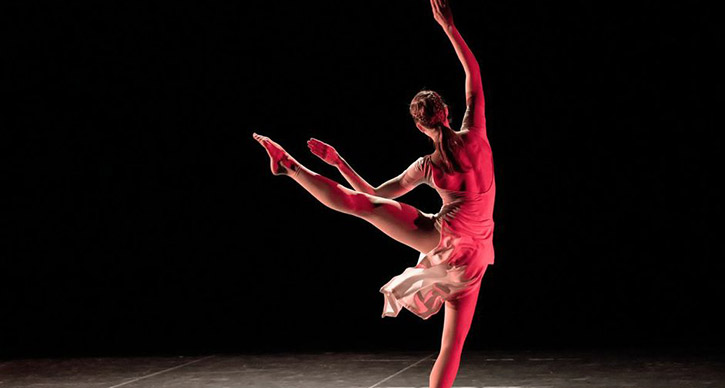
Photo: Trisha Brown Dance Company dancer Jamie Scott performs “If You Couldn’t See Me.” Photo by Alice Gebura.
The Trisha Brown Dance Company performs in Ann Arbor on February 21-22, 2015. Hillary Kooistra, University of Michigan Dance student and UMS intern, spent five weeks with the company during Summer 2014 as part of a new internship program. During her internship, Hillary had the chance to work with the company, and also to sit down with company members and interview them.
Her first was with dancer Jamie Scott. Jamie started dancing with the company as an apprentice in February 2012.
Hillary Kooistra: You’ve actually performed at UMS before with the iconic Merce Cunningham Dance Company. How has your work with the Trisha Brown Dance Company (TBDC) compared to your experience with Merce Cunningham?
Jamie Scott: It’s a very different way of approaching movement for me. A lot of the work that I’ve been doing since I joined TBDC has been re-calibrating the way that I think about movement, the way that I see movement, and the values that I give to different types of movement. There are many similarities, too, with learning repertory that’s been done before and with finding a way to re-inhabit works that have been done.
HK: Aesthetically, what would you say are some of the differences between Trisha’s work and Merce’s work?
JS: They strike a very similar aesthetic or taste from my point of view. But I’d say the biggest difference is that Merce’s work is very externally driven. The movement is very inorganic, and the task is finding a way to do the impossible, to use your muscles and everything you have to make these tasks possible. With Trisha, it’s almost the opposite. There are equally impossible tasks, but I’m trying to strip away as much as I can and re-calibrate force and energy. To find a way to arrive at the impossible form the inside out, rather than the outside in.
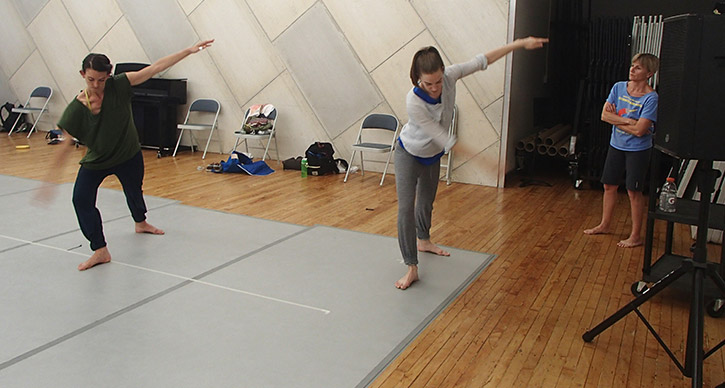
Photo: Jamie and Cecily Campbell (who shares the soloist role in “If You Couldn’t See Me”) rehearse part of the solo with Associate Artistic Director Diane Madden. Photo by Hillary Kooistra.
HK: At Power Center, you’ll perform Trisha Brown’s solo “If You Couldn’t See Me.” I know that you didn’t get to work directly with Trisha Brown in the studio, so how did you prepare, learn, and embody her movement for this solo?
JS: Leah Morrison, another dancer who has performed this solo, taught it to me along with Carolyn Lucas, one of the associate artistic directors of the company. After Leah left the company, we sat down with this amazing archive of footage of Trisha when she was first making the solo. In the video, she is going through the process of creating the movement, just so, and then taking it a step further, and then paring it back. We kind of went along with her whole process, and in doing that we got a lot of physical information that then translated into what you’ll see on the stage.
HK: I’ve noticed that the company often rehearses without music. When you do put on the music, what is that extra layer like?
JS: Actually, working with Merce Cunningham was similar in that respect. We never rehearsed to music, so I’ve gotten used to that. It’s sort of on and off, on and off. But I remember that the first time that I performed to music after rehearsing in silence, it added another dimension in the space. It opened up my awareness, my perception of the space, and gave me something else to interact with. Very tangible, actually. Oddly enough, it seemed very tangible.
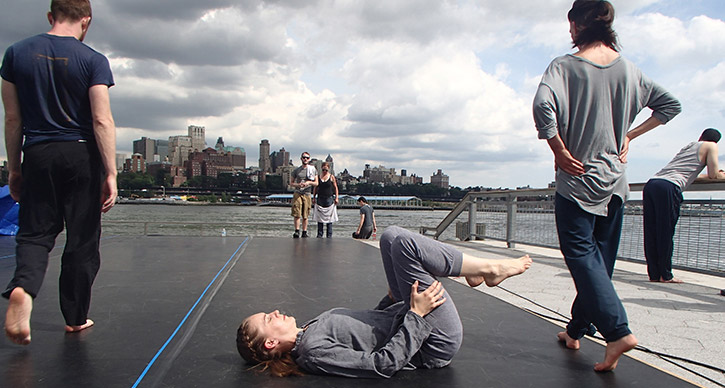
Photo: Jamie warms up before the Company’s performance of “I’m Going to Toss my Arms–If You Catch Them They’re Yours” at Pier 15 for the 2014 River To River Festival in New York City. Photo by Hillary Kooistra.
HK: What would you say is the most challenging aspect of Trisha Brown’s work?
JS: I would say that it’s being honest with movement and not embellishing, not exaggerating, but trusting the simplicity of it.
HK: Trisha’s known as one of the most iconic post-modern dancers and choreographers of our time, partially because of that quality of her movement vocabulary. Do you think that this term “post-modern” accurately characterizes her work?
JS: If we’re talking about stripping away the fluff, which is one of the big tenets of post-modernism in dance, really getting back to the human and getting rid of the fluff, this work continues to do that. This work is all about that, especially the earlier programs. The later work begins to explore, and as with any great artist, the trajectory goes somewhere else.
Read more of Hillary Kooistra’s behind-the-scenes coverage of Trisha Brown Dance Company.
Artist Interview: Leah Ives, Trisha Brown Dance Company Dancer
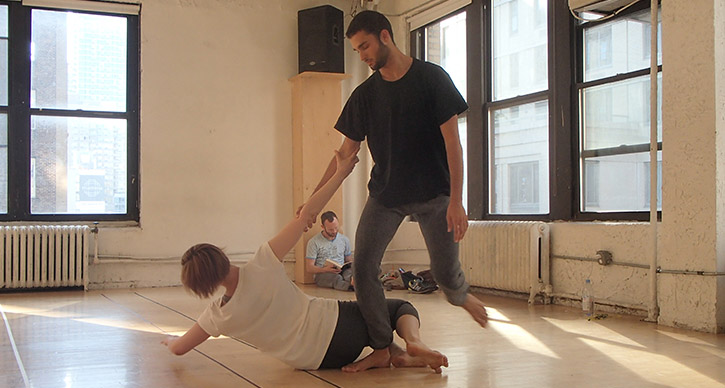
Photo: Trisha Brown Dance Company dancer Leah Ives and fellow dancer Marc Crousillat rehearse a duet from one of many pieces of repertory the two must learn as new members of the Company. Photo by Hillary Kooistra.
The Trisha Brown Dance Company performs in Ann Arbor on February 21-22, 2015. Hillary Kooistra, University of Michigan Dance student and UMS intern, spent five weeks with the company during Summer 2014 as part of a new internship program. During her internship, Hillary had the chance to work with the company on the administrative side and to also sit down with company members and interview them.
Her second interview was with dancer Leah Ives. Leah started dancing with the company in June 2014, and she is also a U-M Dance graduate.
Hillary Kooistra: You’re one of the newer members of the company. Trisha Brown Dance Company is an iconic post-modern company that’s currently in a transition period, and this performance is part of a tour that showcases major stage works. What’s it like to enter rehearsals when the company is in a transition period?
Leah Ives: It’s hard for me to know what it was like for people to enter when the company was not in a transition period. I think we’re very focused on the performances that are coming up, and so in some ways, I imagine that the transition hasn’t fully affected the company quite yet. I feel lucky to be able to jump in and have the chance to perform these works.
I also recognize that this movement hasn’t had as much time to settle into my body and that I have a lot to learn when compared to the other dancers who may have performed these roles and who have had years with these movements and with the pieces settling onto them. I feel like I have a large task to complete in a very short period of time.
HK: Did you always know that you wanted to dance for Trisha Brown?
LI: I was always interested in the company. Once I studied the movement and the repertoire, I found it really satisfying and intriguing mentally. There is a lot of specificity, a lot of attention to detail, and then a lot of of abandoning of that and seeing where that goes in the body.
So yes, I was always interested in the company, but there’s a point when a dancer recognizes that she’s one of many that would love to work for a full-time company, and an iconic company like Trisha Brown Dance Company at that. So, I was content studying the work and getting what I could from the work as a technique, as movement. I am so thrilled to be one of the lucky people who get to actually perform the work.
HK: What are you most excited to share with our Ann Arbor audience? I know the company is doing “Newark” as well as “Set and Reset” (1983).
LI: I’m excited to show the sense of weight and peacefulness in the body that Trisha Brown’s movement is known for. The sort of physics that play through the body in her work may be very different from some of the work that has been presented recently at UMS. I think the pieces we’re performing are really dynamic works, really exciting works, very full of bodies, movement, and interplay between dancers. They’re very exciting pieces to watch.
HK: You graduated from the University of Michigan with a BFA in Dance in 2007. Can you think of work that you did as an undergraduate student at U-M that reminds you of the work you’re currently doing?
LI: While I was there, choreographer Alexandra Beller set a piece with us, and both the interaction between dancers and the grounded-ness of the movement was similar to Trisha Brown’s work. Choreographer Doug Varone also set a piece with us, and the sense of momentum in that piece was very similar to Trisha Brown’s work, the sense of feeling the weight of the arms and the swing through the body. I had also studied with former Trisha Brown Dance Company dancers during the summers and that has really helped me in performing these works.
HK: How is Trisha Browns’s work differed from other dance works that you’ve encountered in your career so far?
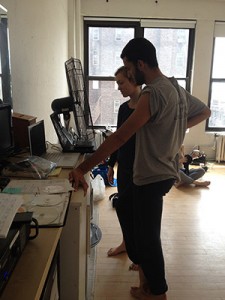
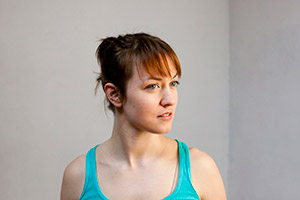
Photos: On left, Leah and fellow dancer Marc Crousillat review choreography from a DVD during some downtime in rehearsal. Photo by Hillary Kooistra. On right, Leah Ives. Photo courtesy of the artist.
LI: Trisha’s work is incredibly intricate in a way that I’ve not encountered very often. It’s very visual, the spacing between dancers is incredibly important. Trisha seemed to have a clear vision of what she wanted in each moment, so we are always trying to re-create that vision.
It’s a tricky process because we are looking at one version of that vision from when the work was originally created, and then maybe another version from ten years later and on a different stage and with different people. This process is very different from what I’ve done in the past.; my other projects have mostly been new works. This concept of taking these roles that were created by someone else and were modified through her body, put onto another body that may or may not have affected the role, and then taught to the person who is now teaching me, is a really interesting way of translating movement. It’s a great challenge. I’m not quite there in the rehearsal process yet.
HK: We’re really looking forward to seeing you on stage back in Ann Arbor! Before we end our chat, can you tell us about your most memorable UMS experience while you were at the University?
LI: The most memorable is hard to pick. I was fortunate enough to live fairly close to Ann Arbor growing up. I lived in Brighton, Michigan. So when I was in Middle School, we had a field trip to the Power Center to see Elizabeth Streb’s Dance Company. That was my first experience with modern dance. It was really exciting, especially at that age, to see people flying through space and their use of trampolines and technology (the soundtrack was based on the bouncing). That stuck with me for a long time.
Another experience that stuck with me was during the Royal Shakespeare Company residency. There were many programs beyond their performances, one of which included a competition of interpretations of a sonnet. I had made a dance based on a sonnet and got to perform it for Patrick Stewart. And I didn’t place, but it’s still something I can brag about! It was a great brag-worthy experience.
Read more of Hillary Kooistra’s behind-the-scenes coverage of Trisha Brown Dance Company.
Student Spotlight: Dispatch from Russia: The Real Interns of the Hermitage State Museum
Editor’s note: Polina Fradkin is a student at the University of Michigan and part of our UMS student intern team. This summer, Polina traveled to Russia for an internship with the Hermitage State Museum. Her travel blog follows, and her experiences include meeting maestro Gianandrea Noseda, the conductor of the Royal Theatre of Turin (which will perform the opera William Tell at UMS this December).
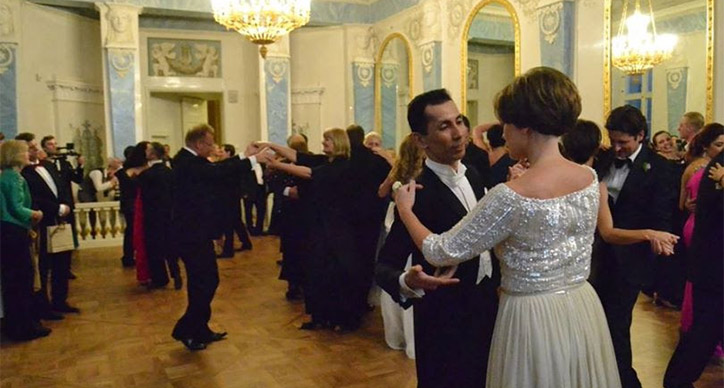
Photo: Moment from the White Nights Gala at the Hermitage. Photo by Polina Fradkin.
Right on Kazanskaya, left on Nevskiy, and through the arch into Dvortsovaya Ploschad’ — there it is, the Winter Palace in all its glory. I think I was so astounded when walking toward it every day that I took a photo … every day.
Some days, there was no work to do in the office, so I wandered the museum halls for hours, at times spending as long as twenty minutes in front of one painting. Some days, I worked for fifteen hours straight, through Gala evenings, European art biennial openings, and operas in the courtyard.
Once, I became best friends with maestro Gianandrea Noseda, the conductor of the Royal Theatre of Turin (which will perform the opera William Tell at UMS this December), and once I had to call an ambulance at two in the morning. A guest at an event had drunkenly cracked his skull in the courtyard. As I compressed the wound, I thought about writing “medical skills” under “museum internship” in my resume.
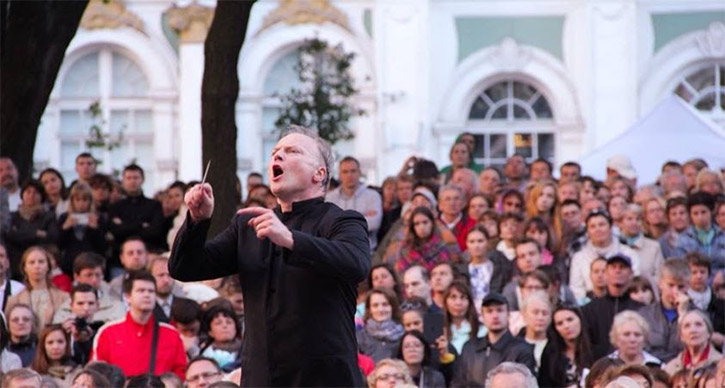
Photo: Maestro Gianandrea Noseda, the conductor of the Royal Theatre of Turin, performs outside of the Hermitage. Photo by Polina Fradkin.
Occasionally I picked up international guests from the airport, and a few times per week, I translated texts from English to Russian and vice versa for the Archaeological department. On Tuesdays, Wednesdays and Thursdays, my friend Emma and I ventured to the Storage and Restoration Facility of the Hermitage and taught English to the restorers. They fattened us up with tea and cookies, and it was a marvelous time, though I think they taught me more Russian than I taught them English.
The most mundane task of all, however, was standing at the entrance and catching people in coats or with backpacks, turning them around, and pointing them to the “garderobe” (that is, coat check). One of my most memorable experiences occurred at these entrance doors, when a certain Russian ex-pat and her American husband tried to push past us with their backpack (inside which might have fit a full grown gorilla), something for which I would have been reprimanded.
“Excuse me,” I said in Russian as I called their attention. “I’m afraid that that backpack will have to be checked.” The woman glared at me. “We were just here last week and they let us through… with the backpack,” she spat back in English. “I’m sorry, it’s protocol,” I responded. Next thing I knew, she had grabbed her husband by the arm and bulldozed through the doors. “Oh no she DI-IN’T,” I thought (or maybe even said it aloud?) as I dove inside and dragged them out by their jackets, using both hands and all of my crowd-parting might. As they finally made their way to check the godforsaken backpack, a relevant quote drew up in my mind, from Pushkin’s Exegi Monumentum: “Never argue with a fool.”
I left St. Petersburg almost penniless, but in my life, I had never felt so rich. Living in Russia sure isn’t easy. Your hummus standards drop drastically and your landlady is probably the worst person to walk the earth. Living these does, however, becomes bearable when one gets as lucky as I was and meets the best people in the world. My family, friends, roommates, co-workers, chefs, kasha addicts, kasha haters, movie watchers, and wine drinkers, French teachers, Shabbat dinner guests, Shabbat dinner hosts, brilliant Laundromat ladies, expert grocery shoppers, art savants, palace enthusiasts, opera goers, two AM bridge-parting watchers, salsa swing and waltz dancers, ogre-like but secretly wonderful flower shop owners, “let’s only speak Russian during dinner every night” attempt-ers, “Polina take the phone I can’t understand the landlady”-ers, and everyone who ever wandered into my home for the past summer, with or without warning. I miss them all terribly.
I miss falling asleep to the familiar clip-clopping of horse hooves down the street. I miss the thrill of exploring my new city. I miss living in a Tolstoy novel. I miss recognizing street names from Gogol and Pushkin tales. I miss Russia, and specifically, St. Petersburg, the place where I learned that losing hot water for weeks at a time doesn’t stop the population from going to the opera, the ballet, the museum. I needn’t have been surprised. After all, what force could interrupt the muse’s reign in Russia’s cultural capital?
Excerpt from “Exegi Monumentum”
by Alexander Pushkin
I’ve raised a monument not made by human hands.
The public path to it cannot be overgrown.
With insubmissive head far loftier it stands
Than Alexander’s columned stone.
No, I shall not die. My soul in hallowed berth
Of art shall brave decay and from my dust take wing,
And I shall be renowned whilst on this mortal earth
Even one poet lives to sing.
Interested in more? Check out other student guest blogs.
Student Spotlight: Could You Repeat That? and Other Stories from Paris
Editor’s Note: Clare Brennan is a junior at the University of Michigan. This past summer she interned for ANRAT, a theater research company in Paris co-founded by Emmanuel Demarcy-Mota, director at Théàtre de la Ville. Their production of Pirandello’s Six Characters in Search of an Author comes to UMS October 24th and 25th.
The summer of 2014 consisted mainly of getting lost. As a first-timer to the grand city of Paris, or to any sort of international travel for that matter, I had incessantly practiced the correct way to ask for directions to the bus stop during my entire eight hour flight. Before I could get a “Bonjour” in edgewise, a bored flight attendant directed me towards my destination in perfect English, and I was on my way.
I’d gladly forget my first trek from the airport to the dorms, dragging my two oversized suitcases across town, but after the jetlag wore off, I started to get the hang of things. I became a lover of maps, discovering the metro system as quickly as possible. That knowledge invariably went out the window as soon as summer construction began. Eventually, I started ending up in the same places, and what was once a completely strange conglomerate of streets started feeling a little more like home.
Once settled in, I dove into the incredible wealth of theater surrounding me. With over 150 professional theaters within its city limits, Paris never let quantity deteriorate quality. One of my first shows was Ionesco’s Rhinocéros at Théàtre de la Ville. I had missed the production when it came to UMS last season, and was so excited when fellow UMS intern Flores Komatsu offered up a ticket to join him. We met at the theater and crossed one of the many bridges that connect the vastly different banks of the river to find a small café for dinner. A group of men of various ages played pétanque, the French equivalent of bocci ball, on a dirt patch next to us, a common pastime on summer evenings. Obviously American, we prattled away, catching up on upcoming projects, book recommendations, and travel plans. Eventually, the couple from Colorado sitting next to us struck up a conversation, and after twenty minutes we had learned the story of their ex-pat daughter and swapped recipes for favorite dishes we’ve discovered. Caught up in conversation, we barely realized we were running dangerously close to curtain time. We sprinted back to the theater and found our seats with just enough time to absorb the atmosphere.
*
I love theaters. Between their velvet curtains and cushioned seats, both actor and audience member gain some security to suspend their disbelief for a while and hear a story. I appreciate that sense of trust that seems built into the walls, and I always try and find it again before every show I see.
At Théàtre de la Ville, the most striking quality I found was its size, housing around 1,500. Our Monday evening show was sold out, and as I looked around, I noticed that most of those in attendance were around my age. In my exploration of the arts at home, I’ve often found truly invested younger patrons more difficult to find. There, young people come to shows, stay for talkbacks, and attend season premieres; Théàtre de la Ville’s season announcement, for instance, packed the house just as tightly as their best-known runs.
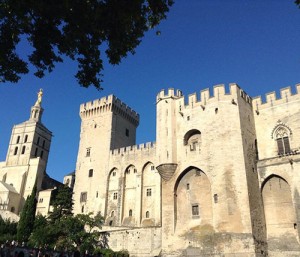
Photo: Le Palais de Pape, where “I Am” played during the Avignon Theater Festival in July. Photo by Clare Brennan
The house lights dimmed, and I experienced again what would quickly become one of my favorite culture moments abroad. Before an actor ever sets foot on stage, a score of audience members will audibly shush one another. It will be hard to forget my first experience of this sort, as the majority of hisses were directed at me. Foreign air and a lack of sleep had left me sick for a couple weeks, and, apparently, I thought that the start of the Moroccan acrobatic performance Azimut at Théàtre du Rond Point would be a lovely time for a coughing fit; the surrounding patrons did not. I quickly picked up this less-than-subtle social cue, and by the end of my two months, I was joining in as passive-aggressively as possible. Strong reactions like this were never out of place. At the Avignon Theater Festival, a production of Lemi Ponifasio’s I Am, a World War II homage in dance, produced critical laughter, side comments, even a small exodus after a particularly difficult movement. However, with this piece included, I also never saw a performance without at least five minutes of applause at the close.
*
Seeing theater in a foreign language took a bit of adjustment. Rhinocéros opens with a beautiful monologue. I couldn’t tell you what the first few lines mean now, as I was still looking for surtitles within the first few moments before I remembered where I was. I did have opportunities to try reading French surtitles during a Dutch production of Ayn Rand’s The Fountainhead and a Japanese kabuki style of the Mahabharata. Reading and translating French while listening to another language with which I had no experience left my American brain a little withered, but it did help me to abandon any pretenses I had when I arrived and dedicate a couple of hours to a completely new experience. Or four and a half hours, in the case of the Dutch Fountainhead. (I have to admit, I dozed off for about twenty minutes of that. I read the book in high school, so that counts, right?)
That night, Flores and I left the theater and lingered on the rainy sidewalk with a crowd of theatergoers doing the same. We all shared our thoughts, compared interpretations, raved over actors, and tried to weave our way through the denser moments. We said our goodbyes for the night, and as I turned to leave, I realized that I was pretty disoriented. I was lost in Paris again, but what else was new. Theater abroad left me dizzy and buzzing, not quite sure of where I stood but happy that I was there. I was used to the feeling by now, and there could be worse places to get turned around. Paris is a city for wandering, anyway.
Student Spotlight: Embedded with San Francisco Symphony
Editor’s note: This summer, UMS launched a new 21st Century Artist Internships program. Four students interned for a minimum of five weeks with a dance, theater, or music ensemble part of our 2014-2015 season. Libby Seidner is one of these students. She spent five weeks with the San Francisco Symphony.
Below, Libby shares her travel stories with the orchestra in advance of their return two Ann Arbor on November 13 and November 14, 2014. They’ll perform two different programs.
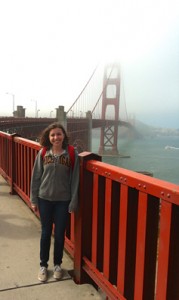
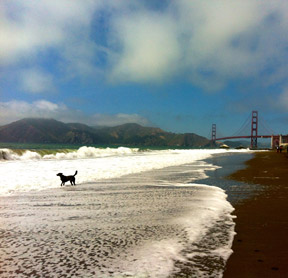
Photos: On left, a photo from my first time on the Golden Gate Bridge. Walking across the Bay to Sausalito was one of my favorite SF activities. On right, view from Baker Beach. All photos by Libby Seidner.
During my first week at the San Francisco Symphony artistic planning coordinator Jim Utz asked me, “You do realize that you’ve come to the busiest symphony orchestra?” I nodded and smiled, but I had no idea what I was in for. At 52 weeks, the SFS has one of the longest seasons of any symphony orchestra. Those 52 weeks are packed with recording projects, album releases, domestic and world tours, concerts for families, as well as fantastic series concerts at their home, Davies Symphony Hall, right in the heart of San Francisco. The Symphony employs 107 musicians and 140 staff.
Being a fly on the wall of this large non-profit organization was an unbelievable learning experience. As part of my internship, I worked on artist interviews, collected behind-the-scenes photos, managed education events, the Britten Festival, an album release, and more. For college students, finding opportunities to work with a symphony orchestra while in season is nearly impossible. The UMS 21st Century Artist Internship program provided me with the professional and education experience of a lifetime.
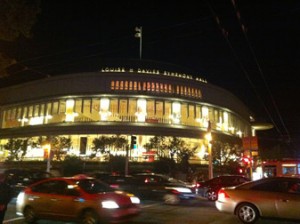

Photos: On left, Davies Symphony Hall at night from street level. The building was designed specifically to look open and inviting from the outside. On right, a view of city hall from the third floor balcony of Davies. It was amazing to see the entire city covered in rainbow to celebrate pride week.
One of my favorite components of the internship was interviewing SFS musicians. I got to know Symphony personnel while discussing repertoire, the upcoming tour, and the historic relationship between UMS and the SFS. Over the course of the interviews, I found myself feeling closer to the orchestra and more connected to the music they were making.
While attending concerts and listening in on rehearsals I had “friends” to listen for. For example, I got to know principal clarinetist Carey Bell, who studied undergraduate clarinet performance and composition at the University of Michigan School of Music, Theatre, and Dance. We bonded over shared experiences of Zingerman’s Deli, the practice rooms of the SMTD and the amazing Ann Arbor student community.
The experience of building these relationships taught me the importance of reciprocity between audience and artist. As an audience member, I am more engaged when I have context. Building relationships with orchestra members reduced the distance I often felt as a listener. I hope to build this bridge for UMS audiences.
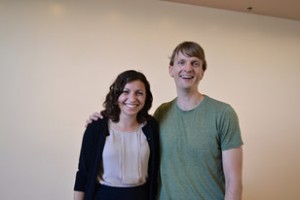
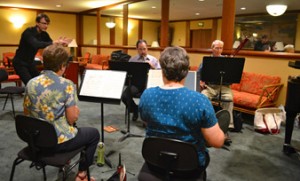
Photos: On left, SFS principal clarinetist Carey Bell and me after our video interview. Carey received his bachelor’s degree at the University of Michigan, studying clarinet performance and composition. On right, Carey Bell coaches a chamber group of local amateur musicians during the Community of Music Makers event.
UMS and the SFS are organizations that work well together because of their shared commitment to access and innovation. Both are looking to provide the best arts experience to as many different people as possible. While I was at the SFS, development of a new series called “Soundbox” was underway. This future concert series will take place in a smaller hall and be directed towards a younger and more diverse audience. The concerts will feature new music and have a host who’ll share insights into the performance.
Similarly, UMS encourages college students and community members to get involved in the arts through programs like U-M classes about the performances, educational electronic media, half-price student tickets, and internship opportunities. These organizations inspire me to think broadly about arts institutions as community organizers. What is the role and responsibility of an arts organization in the community?
One such inspiring SFS initiative that engages reciprocally with the community is the Community of Music Makers program, led by Lolly Lewis of the education department. These events brings local amateur musicians into Davies Symphony Hall to be coached by Symphony musicians and conductors. At the end of a day of hard work and rehearsals, the local musicians have a chance to perform on the Davies Symphony Hall stage.
The performance is the most beautiful part of the event.The musicians perform for each other and a few close friends and family members. The intimacy of the small performance makes the giant hall seem less intimidating and foreign. The idea is to open up the private stage into a public place for genuine civic activity. Not only do the amateur musicians tend to become more engaged audience members and supporters of the SFS, but the Symphony musicians have had a rare chance to meet their audience. The Community of Music Makers program serves as a superlative model for community arts engagement.
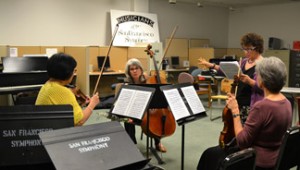
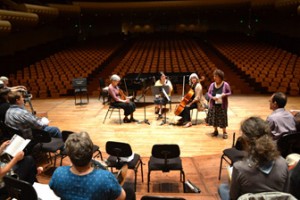
Photos: On left, a local amateur string trio coached by SFS cellist Barbara Bogatin during the Community of Music Makers event. On right, after several hours of coaching, the ensembles perform for one another on the stage of Davies Symphony Hall.
In addition to connecting with the Bay Area community, the Symphony reaches a half a million listeners every year through domestic and world tours, weekly radio broadcasts, and media sales. My internship lined up with the release of the SFS’s recording of West Side Story. This live recording is the first-ever complete concert performance of Leonard Bernstein’s original score.
Having the chance to see what’s involved in a major recording release was an incredible experience. Although many of the media meetings that I sat in on were over my head, the energy surrounding the album release in those weeks was palpable—holding the CDs before they became publically available was thrilling.
The release culminated with a party at the top floor of Twitter headquarters on Market Street. Here, I got to see Michael Tilson Thomas and the stars of the recording up close, as well as hear performances of “Maria” by Cheyenne Jackson (Tony) and “I Feel Pretty” by Alexandra Silber (Maria). #IFeelPretty #SFSWSS #TonightTonight!
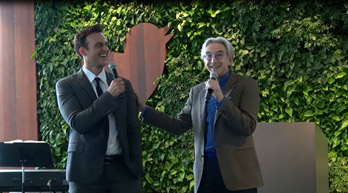
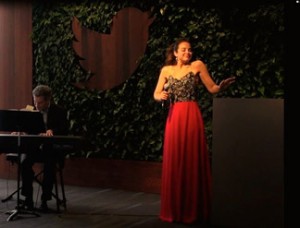
Photos: On left, Cheyenne Jackson and Michael Tilson Thomas at the West Side Story album release party in the Twitter building. Mr. Jackson sings the role of Tony on the album. On right, Alexandra Silber performs “I Feel Pretty” at the West Side Story album release party in the Twitter building. Ms. Silber sings the role of Maria on the album.
My internship also lined up with an SFS series concert featuring international violin soloist Gil Shaham (who’ll also perform in Ann Arbor in November!). Mr. Shaham and the SFS have had over 26 performance engagements together, and the violinist also has strong ties to Ann Arbor, having commissioned and premiered several pieces by U- M composition faculty, including William Bolcom and Bright Sheng.
I was very excited to hear Gil Shaham and the SFS play but never imagined that I would meet him. When I proposed the idea of video interviewing Gil Shaham about Ann Arbor and the upcoming tour, I expected the answer “no.” However, I was surprised and delighted that Mr. Shaham was happy to talk to me!
Meeting Gil Shaham was one of the major highlights of my internship. His extreme musical talent is matched only by his warm personality and approachability. We shared stories of Ann Arbor, performing in Hill Auditorium, the San Francisco Symphony, and UMS. Needless to say, the Ann Arbor music community is very much looking forward to the reunion and return of these artists to the stage of Hill Auditorium this November!
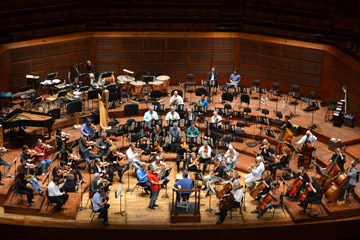
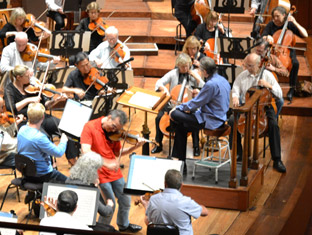
Photos: On left and right, the Symphony rehearses Prokofiev’s Violin Concerto No. 2 with Gil Shaham.
The Symphony’s support in this project was a testament to the character of everyone involved at the SFS. Although I was an intern, not very high up on the food chain, no one treated me that way. Whenever I had an idea or request, I was provided with the resources. I am so grateful to have had the chance to work at such a giving organization.
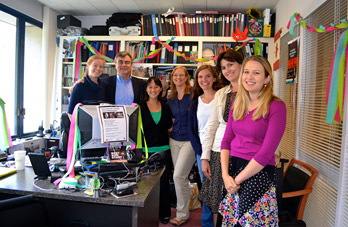
Photo: Several members of the Operations Department celebrate General Manager John Kieser’s birthday. From left to right: Andrea Drummond, John Kieser, Jeannette Wong, Joyce Wessling, Casey Daliyo, Nicole Zucca, and Jessica Huntsman.
Excellence and innovation were terms that I heard frequently around the Symphony office, referring to the talent on stage and off. A world-class orchestra, elite administration, and excellent people, make the San Francisco Symphony so incredibly successful as an international arts leader, a community organizer, and an orchestra. I had an amazing summer working with the best symphony orchestra in the best city. As the song goes, “I left my heart in San Francisco.”
Interested in more? Check out San Francisco Symphony through our archives.
Interview with Ellen Sauer, UMS Student Guest Blogger
This season, we’ll introduce you to some of our audience members as part of our “Who’s sitting next to you?” series. To kick things off, we chat with Ellen Sauer, junior at Pioneer High school, who’ll also occasionally blog about her performance experiences for UMS Lobby.
UMS: Please introduce yourself.
Ellen Sauer: My name is Ellen Sauer, I am 16 years old, and I am going to be a junior at Pioneer High school next year, where I play flute and piccolo in Symphony Band and Symphony Orchestra, and sing in A Cappella choir.
UMS: During our chat, you said that you’re passionate about music. How do you think this spark got started for you?
ES: I come from a very musical family. My parents both play(ed) the clarinet and met in music school, so music is central in our family’s life. I have been going to concerts and recitals, mostly classical, since I was two or three years old and continue to attend up to two or three a week during concert season. My dad has also been listening to recordings with me for as long as I can remember. I think what I’m trying to say is that music became important to me the moment I was born, and I have become more and more passionate with time.
What kinds of performances or arts experiences do you like to attend?
ES: I really enjoy orchestral concerts because I am probably the most familiar with orchestral repertoire and love the warm sound that an orchestra can produce. My favorite orchestral concert was the Mariinsky Orchestra’s rendition of Scheherazade a few years back. I also enjoy solo performances, predominately flute, but I have been to a broad array of solo and chamber music recitals, including a rather experimental bassoon one. Outside of classical music, I enjoy big band jazz, stage plays, and musicals. I really enjoy combined arts experiences that appeal to, but don’t over-stimulate, all of the senses. My best example of this would be the photo gallery that accompanied the New York Philharmonic performances last year, as well as the interview with musicians and the photographer following Saturday’s program.
UMS: Are you a performer yourself? How did you decide to pursue your instrument?
ES: I play flute and piccolo both as a soloist and in several curricular and extracurricular ensembles. I started on clarinet in fifth grade music class because all of the musicians I looked up to played the clarinet, and I figured I was genetically coded to play it. After a particularly painful few months, my mother was fed up with reminding me to practice and tired of putting up with my squeak-laden tone, so she suggested that I try the flute sitting in her closet from her band-directing days. I was equally upset with my progress, so I readily agreed. By the end of the week I knew my B-flat scale, a feat that had taken three months on clarinet, and by the end of the year I had an open-hole flute and private lessons. Looking back, it seems that flute chose me more than I chose flute. I began playing piccolo in the eighth grade for the Blue Lake and Slauson orchestras and continue to play it in school ensembles.
UMS: Do you have a favorite piece of music?
ES: I can’t say that I do have a favorite piece of music. All music is so unique and so wonderful that there really are no grounds for comparison. The same chord progression and simple melody can be put to counter point so many ways, the same lead-sheet can produce so many improvised solos, and even the same classical composition is played and interpreted differently every time.
UMS: You’re entering your junior year at Pioneer High School. Do you have a sense of what you might want to do after your graduate?
ES: I am excited to pursue a flute performance major, hopefully paired with a religion double major. Social justice and volunteer work are also two things very dear to my heart, so I am sure those will somehow figure in to my long-term plans.
UMS: Anything else we should know about you?
ES: I love sewing. In eighth grade I sewed a historically correct, civil-war era, purple satin gown and also made the hoop to go with it.
Look for Ellen’s writing on UMS Lobby this season!
Do you want to nominate someone you know for our “Who’s sitting next to you?” series? Email your suggestion to ums-lobby@umich.edu


